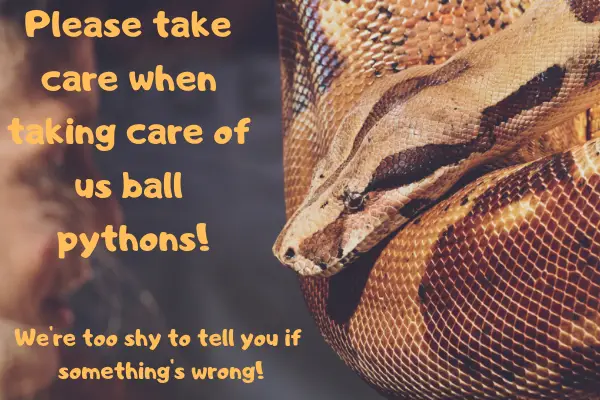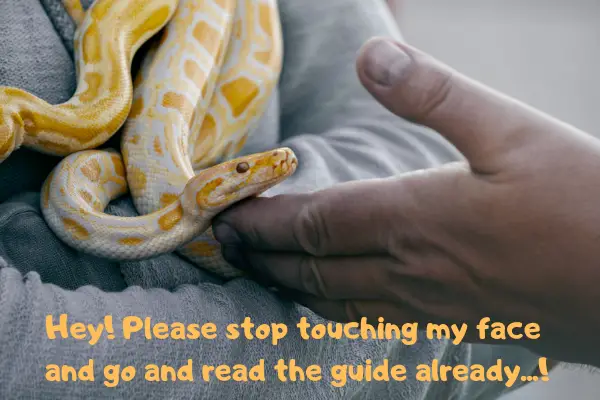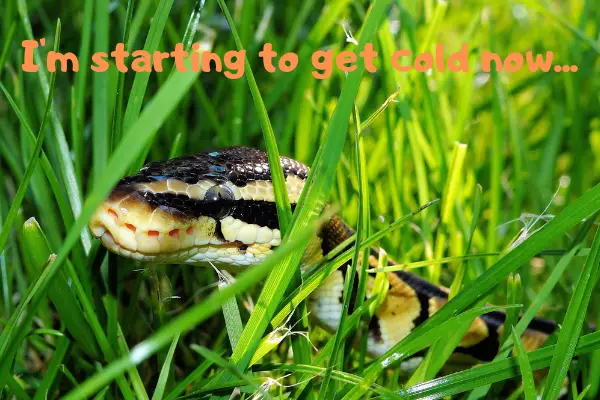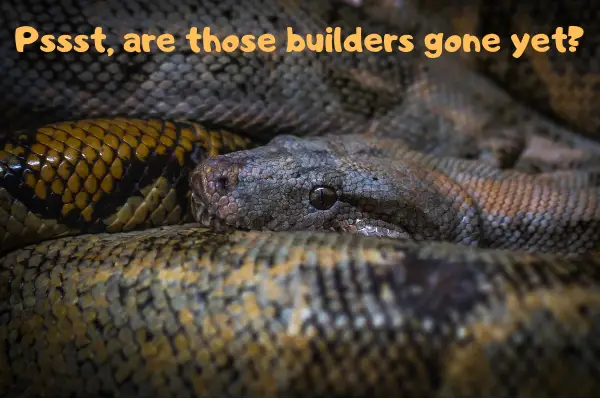Taking care of a ball python isn’t as hard as it may seem. When you first start out in reptile keeping, it can be quite daunting. Luckily, we at UrbanReptiles have got your back! In this ball python care guide, we’ll take you through everything you need to know when it comes to ball python care, both for beginners as well as more experienced reptile owners.
We’ve also created a quick ball python care sheet you can copy and print out to ensure you never forget anything. This acts as a cheat sheet that you can reference anytime you’re not quite sure what to do, or if you’ve forgotten something like the ideal temperature, or when you should feed your new pet!

Table of Contents
Ball pythons
Ball pythons are native to sub-Saharan Africa, where they live in the hot grasslands of the savannah. They are mostly active at night and spend most of their time hiding from larger predators.
They are quite timid animals and get their name from their tendency to curl up into a ball when they feel threatened. This probably doesn’t get them very far in Africa though…
They are also called royal pythons in a lot of countries, due to the fact that they are so docile that they used to be worn as a kind of decoration by royalty. Talk about “bling,” hey…
These cute and calm little pythons are one of the best pet snakes you can get. They are also one of the most popular and are loved by both casual python keepers as well as extremely fanatic herpetologists. They come in all sorts of different pattern variations called morphs, which are predominantly decided by their genetics. This is another reason why they’re so popular amongst breeders, as there are endless beautiful gene combinations that can be achieved.
Ball python care sheet
Below, you’ll find the article summed up as briefly as possible. After reading the article in its entirety, you can use this ball python care sheet to check up on if you’re doing everything right every once in a while.
This ball pythons care sheet doesn’t contain all the information, only the most important takeaways!
Ball python enclosure:
- 20 gallons for a baby, 30-40 gallons for an adult
- A cold hide and a warm hide
- Water dish the python can fit into
- Ball python specific substrate or paper towels
- A humid hide to help with shedding
Heating and temperature
- Heat mat is preferred. Heat lamp also an option
- DON’T use a heat rock
- 89-97 degrees Fahrenheit (31.5 – 36.1 degrees Celsius) basking temperature (ground temp. in warm side of enclosure)
- 79 – 83 degrees Fahrenheit (26.1 – 28.3 degrees Celsius) air temperature.
- About 30% of the enclosure should be heated, the rest unheated
Humidity:
- 50% to 65% humidity in the terrarium
- 65-75 percent humidity when shedding
Feeding:
- Can feed live and pre-killed (frozen) rodents (rats and mice). Frozen and pre-killed is preferred because it prevents parasites from entering the terrarium
- Feeder rodents should be properly thawed, and preferably heated slightly under a lamp or by placing in warm water before offering to your ball python.
- If your ball python isn’t eating, it could be because they are about to shed, it’s winter, or they are stressed. Be patient, keep en eye on your ball pythons weight and track their feeding habits. You’ll soon learn what’s normal and what isn’t.
Shedding:
- Your python may get anxious during shedding because his/her vision is impaired. It’s best not to handle your ball python while shedding for this reason.
- Raise humidity to 65-75% during shedding
- If pieces of shed skin get stuck, place ball python in a moist hide/enclosure for 30-60 minutes, then let them back into their terrarium. It should fall off within 12 hours or so.
- If there are large shedding problems, take them to the vet for a checkup.
Use this summary as a cheat sheet for caring for your ball python. This way, you can reference the cheat sheet whenever you need to.
Ifany questions come up while reading this care guide or you want more information, check out our other posts on ball pythons.
Ball python care guide
Now it’s time for our complete guide to ball python care. We’ve done our best to be as thorough as possible in this guide, so you can learn exactly how to care for your ball python. If you feel like we’ve missed anything, or you have any questions, please feel free to send us a message and we’d be more than happy to answer them and/or add them into this post!

In this care guide, we’ll cover the following topics:
- Enclosure setup
- Feeding and hydration
- Heating and humidity
- Shedding
- Buying your ball python
- Ball python care FAQ’s
We’ve got a lot to cover in this post, so lets dive straight in!
Enclosure setup
In the wild, ball pythons live in quite a harsh environment. They also have the tendency to hide a lot, be it in termite mounds, small tree hollows or small rodent tunnels.
Luckily, this doesn’t mean you have to build a termite mound in your python’s terrarium. It is something that you should keep an eye on though, when selection your terrarium and hides, as it’s our responsibility to provide our pet snake with the best possible habitat to thrive in.
Terrarium:
Imagine being trapped in a small, dark, cramped place. Maybe your siblings locked you up somewhere when you were little, or you grew up under the stairs like Harry Potter.
We’re guessing it’s not the place where you feel most comfortable.
The same can’t be said for your pet ball python though!
Ball pythons feel safest in small areas, preferably where nothing can creep up on them from behind. We’ll get into hides in a moment, but this has an impact on the type of terrarium you buy for your pet snake too!
30-40 gallons for an adult ball python is more than enough. For a baby, you can go as small as 5 gallons. Just keep an eye on the size as they grow though, as it’s important to give them plenty of room to move around too.
The way you structure the inside can have some impact on the ideal size of your enclosure too, though. If you give them more hiding places and less large open spaces, you can generally get away with a bigger enclosure when they’re still young too.
When buying a ball python terrarium, you also need to watch out that they can’t escape!
They’re no Dynamo or Harry Houdini, but snakes are quite the magicians when it comes to wriggling out of setups.
Make sure your terrarium has a specially designed lip that prevents a snake from forcing its way through the opening.
Most terrariums that are designed for reptiles are fine, just keep an eye on the lip and make sure they close properly!
You can also use plastic containers with locks on. Those ones you use to store things under your bed. It’s debatable whether this is the best enclosure for your ball python to flourish in though. It also doesn’t look very good!
As long as you give them plenty of breathing holes, these containers work fine too. Make sure they’re the ones that can be shut properly though, to prevent any escape attempts.
Substrate:
Spend 5 minutes reading a reptile forum, or read a few blog posts, and substrate is always something that’s argued about endlessly. This goes for pretty much all pet reptiles, not just ball pythons.
It seems like the more you look, the louder people are shouting to stay away from, well… Pretty much every substrate there is!
Paper towels aren’t natural and are hard to clean, aspen shavings won’t work because they aren’t from the ball python’s habitat and us reptile keepers don’t enjoy shaving… You get the point. All the shouting and arguing doesn’t do the community any good.
The main takeaway from this part is that ball pythons are relatively clean animals, and the substrate you use is down to preference more than anything.
Paper towels work fine, only they require a little more cleaning. This is because spot cleaning is harder than when using

Normal substrates that are made for ball pythons, (including aspen shaving!) tend to work fine. These are easy to keep clean too, as you can just scoop a little bit out when needed.
You should completely clean the enclosure regularly too, but spot cleaning will help to keep things nice and clean, and prevent any toxic ammonia from building up.
Obviously, paper towels don’t look as good as regular substrate. As well as this, they don’t retain humidity as well, so you may have to place their water bowl near or on the heat mat slightly, or use a humidifier.
We’ll get to humidity in a bit, but choosing the right substrate can help you keep humidity levels a little higher. If this is necessary depends on the room where your ball python is located and the climate you live in.
Hides:
Your ball python needs hides. They tend to spend a lot of their day hidden away in their hide, as they would do in the wild.
You should provide your ball python with at least two hides. One should be on the warm side of the enclosure, and one on the cold side. This allows them to regulate their body temperature. Since all reptiles are cold-blooded, they have to use external temperature changes to regulate their body temperature. This process is called thermo-regulation.
The hides should be properly enclosed too. Those little half tree things you can find at pet stores are great to add to the enclosure, but don’t count as one of the hides since they have two open sides. Try to give them hides that are properly closed off, with just a single entrance that isn’t too large.
Water dish:
You need to provide your ball python with a water dish that they fit into. It shouldn’t be extremely deep, but they should be able to fit in it.
Just as we might like to take a bath every now and again, so do ball pythons. It also helps them to thermoregulate, and they might like to use it when shedding. The extra moisture helps to loosen the skin when shedding, so it’s common to find ball pythons in their water dish when they’re about to shed.
Important: Make sure you keep your ball python’s water dish clean. Always remove any shed skin and feces, and refresh the water regularly.Dead skin and feces can cause ammonia to build up, especially in water. Clean drinking water is vital to life, so making sure their water dish is kept clean is very important.
Humid hide:
It’s good practice to provide your ball python with a humid hide, especially during shedding. This can be a hide with a bedding of sphagnum moss, which helps to increase humidity levels. You can also spray a little bit of water inside the hide if sphagnum moss isn’t available.
It’s best to just provide a separate moist hide during shedding. If they don’t have the choice between moist and dry, then they can spend too much time in the moist and humid areas. This can lead to scale rot and other medical conditions which is very bad for your snake.
If you provide a separate moist hide during shedding, along with the two dry hides, this won’t be a problem.
Other objects:
You can place a whole range of other objects into the enclosure, but most of the time, this is more for you than for the snake.
It helps if they have something a little rough to rub up against when shedding. Apart from that, snakes who are raised on just the basics tend to perform just as well as snakes with more extravagant setups. That being said, happiness isn’t something you can measure easily in snakes, so there’s a valid argument to be made in favor of more natural setups. This is also what we tend to recommend, as a habitat that best mimics where they live naturally tends to look adn feel better.
Tips:
- Make sure that everything that you place into your enclosure is secure. Snakes are quite clumsy and can knock things over if they aren’t heavy enough or aren’t fastened.
- Don’t add random things to the enclosure if they weren’t bought at pet stores. You can treat wood and other materials to be suitable inside terrariums (google it! Here’s a link), but don’t go adding things randomly. You could add pests or illnesses into the enclosure that can be damaging to your ball python’s health.
- Don’t just read this guide and dive straight in, do your research! Here’s an article on ball python terrarium setup on our blog. Make sure to check out other resources like getting in touch with someone nearby who may be able to help you set up your enclosure.

Heating, lighting and humidity
Ball pythons come from Africa, so you can probably guess that they need some form of heating in their enclosure (although this somewhat depends on where you live!).
Ball pythons aren’t reptiles that like to bask in the sun, but they do enjoy the warm ground once it goes down. Since reptiles are cold-blooded, they need external heat to regulate their body temperature.
This is called thermoregulation, and it’s therefor important to provide your ball python with a mix of temperatures in its terrarium.
Humidity is another important point, especially when it comes to shedding. More on that later though!
A note on heating a ball pythons enclosure
A ball python should only have about 30% of its enclosure heated. This ensures for about 33% of the enclosure to be heated, allows for about 33% transition and then 33% of the enclosure to be cool.
The exact amount of the enclosure that’s in transition will differ depending on the heat source you use and the climate you live in. That part isn’t very important though, the important thing is to ensure about 30-35% of the enclosure is heated.
Heating
A ball pythons enclosure needs heating. Since they aren’t avid baskers and prefer to enjoy the heat projecting from the ground after the sun has gone down, a heat mat is usually the best way to go.
However, as with all things when it comes to reptile keeping, this is debated heavily!
Each form of heating is going to be covered in this ball python care guide. We’ll start with the option that’s advised most often.
Heating your ball python’s enclosure with a heat mat
Using a heat mat to heat your ball python’s enclosure comes with quite a lot of advantages. First, they get their heat from the ground in the wild too, so a heat mat provides them with their proffered source of heat. This means that it’s an effective way of heating the enclosure, especially since the heat doesn’t have to travel as far, so it costs less electricity.
A heat mat should always be placed underneath the terrarium and not in it. This prevents any accidents from happening inside the ball python’s terrarium, since electronics and water don’t tend to mix well.
Also, the heat mat should be just a small distance away from the terrarium, and not fully touching it. Your talking millimetres here and not inches! It also shouldn’t touch the surface it’s on.
This prevents the heat mat from overheating, and causing problems. It’s usually achieved by ever-so-slightly raising the terrarium off the surface it is one, allowing for a thin layer of air to prevent the mat from overheating.
You should also be careful not to put a too thick layer of substrate above the heat mat inside the enclosure. Some substrate is good, just don’t overdo it as it can prevent the heat from reaching the surface.
To ensure that the temperature is exactly right for your ball python, you can use a thermostat to ensure that it’s set precisely. These can be connected to the heat mat and ensure the temperature stays steady.
Heating your ball python’s enclosure using a heat lamp
It’s also possible to heat your ball python’s enclosure using a heat lamp, but there are a few big disadvantages to this.
The first is that ball pythons aren’t reptiles that bask, so a lot of the heat is wasted unnecessarily. They get their heat from the ground, so a heat mat is much more efficient.
Something else to be aware of is that a heat lamp causes the air in the enclosure to heat up a lot more than a heat mat. This is fine if you keep the room cold but can cause problems with thermo regulation in a small terrarium.
A ball python’s terrarium is generally small. A heat lamp often covers a much larger, and less specific area, than a heat mat does.
This can cause problems, as there may not be a cold area for your snake to go to escape the heat.
Heating your ball python terrarium with a heat rock
Don’t do it. Heat rocks can’t be regulated using a thermostat and are prone to overheating. Also, because there is nothing on top of them to even out the heat, they often have hot spots and cooler spots.
This can cause your pet ball python to burn! It’s best to stay away.
Temperature

The temperature you keep your ball python’s terrarium in will have a huge impact on their health.
The warm basking area in your ball python’s enclosure should be about 89-97 degrees Fahrenheit (31.5 – 36.1 degrees Celsius). This is what the ground temperature should be, ideally with a lower air temperature.
You should check the ground temperature using a digital thermometer. This makes it possible for you to measure the exact temperature of the surface, without having to enter the enclosure.
This also enables you to check the temperature regularly and measure the gradient to ensure there is enough room on both the hot and cold side of the enclosure.
The air temperature in your ball pythons terrarium should be about 79 – 83 degrees Fahrenheit (26.1 – 28.3 degrees Celsius). This can usually be achieved with either a heat mat or a heat lamp.
Inside your home, the temperature probably isn’t all too far off of this (depending on where you live) and a heat mat will generally make enough of a difference to the temperature of the terrarium. A heat lamp has the tendency to heat up the air a lot more, which can cause issues with the terrarium getting too hot.
You should measure the air temperature using a thermometer. You can usually get one that’s specially designed to stick to the glass of a terrarium, and that’s a great option as you can check up on it regularly without too much effort.
If you get one that also shows the humidity, then even better!
Lighting
A ball pythons enclosure doesn’t have specific lighting requirements. Generally, natural lighting, together with the lights in the room the terrarium is stationed, will provide ample light.
If you want a light for improved viewing, then make sure to turn it off at night. This helps to simulate a normal day and prevents confusion with lights randomly going on and off.
Humidity
When it comes to humidity, ball pythons aren’t the most difficult animals to keep. With a good substrate and creative water dish placement, you can deal with the humidity without humidifiers.
You should strive for a humidity level of between 50% and 65% within your ball python terrarium. This being said, it doesn’t matter if this number drops or peaks on occasion as long as this average is maintained.
In the wild, humidity levels are obviously not controlled at all. As long as you aim for a humidity level between the 50 and 65 percent mark, you should be fine. Just don’t let it drop below this amount or rise above it for extended periods of time.
By using normal ball python substrates, you can raise the humidity level in the terrarium. You can also place the water dish a little closer to the heat source to raise it further if needed.
This causes more of the water to evaporate in a shorter timescale, hence raising the humidity. Just don’t put it all the way on the heat mat as this will cause the glass sides of the terrarium to fog up and condense.
This can cause the moisture to leak down again and make the substrate all damp. Damp substrate can cause scale rot as well as other health issues in ball pythons, so it’s best to avoid this.
When it comes to shedding time, it’s best to raise the humidity to about 65% to 75%. This will help your ball python to shed properly. Once the shedding is completed, you should lower the humidity back to normal levels (50-65%).
Read more about heating and humidity in ball python enclosures here.
Feeding and hydration
When it comes to pets, they usually love their munchies. Ball pythons, however, are a little different. They are notoriously fussy eaters and often don’t go for prey you offer them. This problem is usually worse for new pet owners and gets better as you get to know your python.
Unfortunately, this often results in a lot of feeder animals being thrown out.
Although this isn’t true for all ball pythons, a lot of them are quite sensitive, and they easily don’t feel like feeding.
This can have a number of cause, but just some of these are stress, bad living conditions, illness and shedding.
If your ball python isn’t eating, you need to get your sherlock holmes on.
Is the terrarium in a busy part of the house? Is there a lot of noise near the enclosure? Are you checking up on the snake too often and forcing him out of his hides, for example?
These are all things that can stress a snake out. As with all animals, when they are stressed, they often don’t eat as well.

If you think stress may be a major cause of your ball python not feeding, then try changing its environment or removing the things that may be causing it stress.
Shedding is also one that often catches people off
This is perfectly normal, and sometimes it may just require a little more patience. They may still eat after a little while. If not, don’t stress though. They should start eating again after the shedding has stopped.
In the winter, some ball pythons may choose to just stop eating for a while. Some won’t but others will.
If your ball python stops eating in the winter, just keep a close eye on its weight and keep trying to feed it regularly. If you become really worried or you notice its weight dropping, then take your ball python to the vet. This is something that not enough reptile keepers do!
The main thing when it comes to ball python feeding, is patience. Just take your time and get to know your snake. After a while, you should start getting to know their habits. Keeping an eye on the snake’s weight also helps you to spot and potential issues sooner.
What to feed your ball python
This is another aspect of ball python care that a lot of people debate, maybe less so than the other popular discussion points though.
When it comes to what to feed your ball python, mice and rats are the staple food.
You’ve got two options, but one is greatly preferred above the other. The first, and less preferred option, is to feed your ball python live feeder animals.
The main problem you have with this is that the rats and mice that you drop into the enclosure along side your ball python, may cause your ball python some problems.
When a ball pythons decides not to eat, then it isn’t going to strike at the mice. The mice, being the sneaky and hungry little rodents that they are, will pester the snake, or even start eating it!
If you do try to feed live mice or rats to your ball python, then make sure to supervise the feeding session. If they don’t feel like eating, then make sure you remove the mouse or rat.
Another problem with live feeder animals, is that they can carry parasites or illnesses into the terrarium. This can also negatively effect the health of your ball python.
There is also the ethical issue that a lot of people have with feeding live animals to consider…
What’s the best option to feed your ball python?
The best option when it comes to ball python feeding, is frozen rodents like mice or rats. Once they are frozen, the parasites that they may otherwise carry with them into the enclosure are killed.
Also, any problems you may have had with the rodents attacking your ball python are gone, as they are already pre-killed.
If your ball python isn’t used to pre-killed rodents then it may be quite a challenge to get them used to eating them. However, it’s certainly worth trying to get them used to feeding on pre-killed/frozen prey, due to the health benefits.
Always make sure to properly defrost/thaw your feeder animals before feeding them to your snake! Failing to properly thaw the feeder animals all the way to the inside can cause your snake to cool down from the inside.
This is a very unnatural way for a snake to lower its body temperature and can cause problems in the snake.
How to feed

Obviously, you want your frozen feeder animals to be thawed completely. You can do this by leaving them outside the fridge for a while, or even putting them into a glass of warm water.
Do not under any circumstances microwave the rodents. This causes hotspots and prevents it from thawing properly. If it does completely heat up then it gets far too hot. On top of all of this, feeder animals have been known to explode in the microwave… Unless you’re in the mood to have pieces of dead mouse on top of your mac & cheese, it’s best not to get the microwave involved.
All snakes have little pits around their mouth which allow them to “see” heat. This makes it easier for them to determine what is prey, and what isn’t. This is also another reason why cold/frozen feeder animals won’t work very well, since it won’t see them as prey.
It can help to slightly warm up your feeder rodents before dangling them in front of your python. Again, don’t do this is the microwave, and I’d avoid the oven too.
By placing them in a bowl of hot water, or underneath a heat lamp (if you have one plugged in somewhere) is more than enough. If your snake isn’t feeding, then this may be the thing that makes all the difference.
Always use tongs when feeding your ball python and try to move the prey around a little bit if they aren’t too keen straight away. This will prevent them from missing the prey animal, or accidentally seeing your hand as prey.
Tip: Some people like to move their ball python into a separate enclosure for feeding. This prevents them from seeing you as a potential prey item when going into their enclosure for spot cleaning for example.
This isn’t a must but may help if your ball python has the tendency to have a go at you when you enter its terrarium.
A word on hydration
Ball python hydration isn’t all too complicated but needs to be discussed in this care guide.
Just ensure you provide them with a water dish that’s large enough for them to fit in completely. They will drink or lay in there whenever they feel like it.
Make sure the water is kept clean and refreshed often. Water can go bad quickly, especially if it gets dirty.
Also, make sure you don’t place the water dish onto the heat pad. This will cause the water to evaporate too fast.
Shedding
In this ball python care guide, we couldn’t leave out the shedding process since it’s such a stressful time for many python keepers.
When it comes to shedding, ball pythons are relatively easy reptiles. They shed their skin roughly every 4 to 6 weeks, and more often than not shed their skin in one fell swoop.
Their skin tends to peel of like a banana, starting at the head and peeling down to the tail. In healthy snakes, it will come off in one piece, although there may be a few pieces that break off during the shed.
The shedding process of ball pythons starts a few weeks before they actually shed. You will notice that their skin color gets duller and the eyes will start turning a blueish color.
This is all due to the skin that’s starting to come off.
Ball pythons tend to be a little agitated once shedding begins. This is because their vision is often a little cloudy and they are therefor more easily spooked by things. It’s best not to handle your ball python when they start shedding.
Once you start noticing the shedding process is beginning, raise the humidity in the enclosure to 65-75 percent.
Also, ensure they have something to rub up against once they actually start shedding. In most cases, water bowls or hides work fine, and this isn’t something you need to think about. In some setups you do, however.
If this is done, you should be good to go!
If there are ever pieces of skin that don’t come off, you can try placing the ball python in a moist hide for 30-60 minutes. After you’ve placed them back in their enclosure, it should come off after another 12 hours or so.
If you are experiencing bad shedding problems, it’s best to take your pet ball python to the vet for a checkup.
Tips when buying your ball python
We could go on and on about different tips to keep an eye on when buying a ball python, but below are a few of our favorite and/or most important ones.
- Make sure you consider alternatives, as well as whether to go for a male or female ball python. Check out our post on the differences between ball pythons and corn snakes for example, since these are the two best pet snakes for beginners. This will help you to make sure you get the best pet snake for you.
- Learn your stuff first. Make sure you know how ball pythons should be cared for, as this will make it possible for you to check if the breeder you’re buying fromis caring for their animals properly.
- Don’t buy from pet stores or from breeders that aren’t providing proper care. These animals might be sick or have pests that can be a nightmare to deal with.
- Check the reviews online! People can’t hide what others are saying about them online, so make sure to check for reviews to see what other people’s experience was when buying from this breeder.
Conclusion
It was a long one, but we hope that this ball python care guide has helped you on your way. We always recommend our readers to get their information from different sources, so make sure you check out other care guides online too, as well as look for answers to your questions. If you can get in contact with someone who has experience working with ball pythons and can help you out directly, this can be very valuable too!
